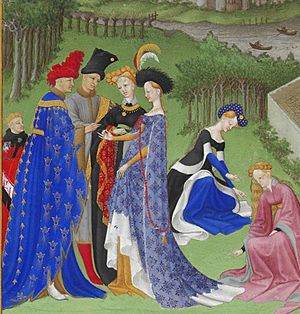Fashion in the 15th century facts for kids

Fashion in the 15th century in Europe was full of exciting and sometimes over-the-top styles! People wore everything from huge, flowing gowns with super long sleeves to tight tops and leggings. Hats and other headwear became very important too. They were decorated with jewels, feathers, and drapes. Early in the 1400s, big gowns called houppelandes with huge sleeves and fancy hats were very popular.
As Europe became richer, more people, especially skilled workers in cities, started wearing more complex clothes. These outfits often copied, in a simpler way, the styles of the very rich. It also seems that clothing styles started to look more different from one country to another during this century.
Popular Fabrics in the 1400s
Wool was by far the most popular fabric for everyone, no matter how rich they were. After wool, people used Linen and Hemp. Wool fabrics came in many different qualities. You could find rough, undyed wool or very fine, thick wool that felt like velvet. High-quality wool fabric was a big part of England's economy. It was sold all over Europe.
Colors and Dyes
Wool fabrics were dyed in rich, bright colors. Red, green, gold, and blue were very popular. However, the blue color made from dyes like woad (or sometimes indigo) wasn't as bright as the amazing blue color you see in old paintings. Those paintings often used a very expensive blue pigment called Lapis lazuli.
Silk and Fancy Patterns
Silk weaving was already well-known around the Mediterranean Sea at the start of the 1400s. Fancy silks, especially silk velvets with silver threads, became more common. You could see them in Italian clothes and on rich people across Europe. Beautiful flower designs, often showing a Pomegranate or Artichoke, had come to Europe from China in the century before. These designs became very popular in the Ottoman Empire's silk-making cities like Istanbul and Bursa. From there, they spread to silk weavers in Florence, Genoa, Venice, Valencia, and Seville during this time.
Fur as Fashion
Fur was worn mostly as a warm lining inside clothes by those who could afford it. The grey and white squirrel furs, called vair and miniver, which were popular in the Middle Ages, went out of style. This happened first for men, then for women. The new fashionable furs were dark brown Sable and Marten. Towards the end of the century, furs from wild animals like Lynx became popular. Ermine fur, which is white with black tips, remained a special sign of kings and queens.

